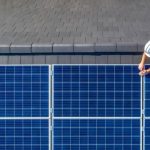Hall Effect was named after Edwin Hall, its discoverer. This is somewhat similar to Fleming’s right hand rule. When a current carrying conductor I is placed in a transverse magnetic field B, an electric field E is induced in the conductor perpendicular to both I and B. This phenomenon is called as Hall Effect.
Explanation
When a current carrying conductor is placed in a transverse magnetic field, then this magnetic field exerts some pressure on the electrons which take a curved path to continue their journey. The conductor with energy applied is shown in the following figure. The magnetic field is also indicated.

As electrons travel through the conductor that lies in a magnetic field B, the electrons will experience a magnetic force. This magnetic force will cause the electrons to travel close to one side than the other. This creates a negative charge on one side and positive charge on the other, as shown in the following figure.

This separation of charge will create a voltage difference which is known as Hall Voltage or Hall EMF. The voltage builds up until the electric field produces an electric force on the charge that is equal and opposite of the magnetic force. This effect is known as Hall Effect.

Fmagnetic−→−−−−=FElectric−→−−−−=qVD−→B→=qEH−→Fmagnetic→=FElectric→=qVD→B→=qEH→
VD is the velocity that every electron is experiencing
EH−→=VD−→B→EH→=VD→B→ Since V = Ed
Where q = quantity of charge
B→B→ = the magnetic field
VD−→VD→ = the drift velocity
EH−→EH→ = the Hall electric effect
d = distance between the planes in a conductor (width of the conductor)
VH=εH=EH−→d=VD−→B→dVH=εH=EH→d=VD→B→d
εH=VD−→B→dεH=VD→B→d
This is the Hall EMF
Uses
The Hall Effect is used for obtaining information regarding the semiconductor type, the sign of charge carriers, to measure electron or hole concentration and the mobility. There by, we can also know whether the material is a conductor, insulator or a semiconductor. It is also used to measure magnetic flux density and power in an electromagnetic wave.


